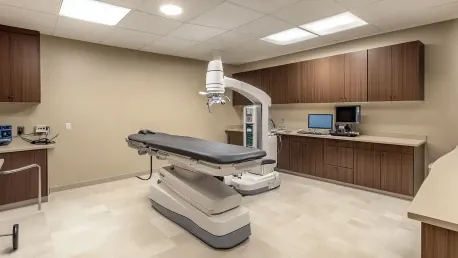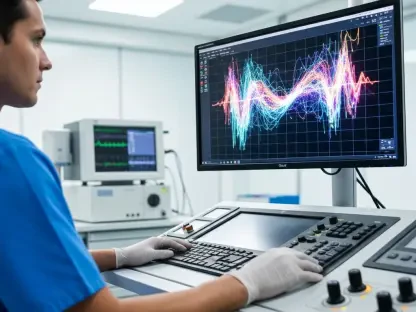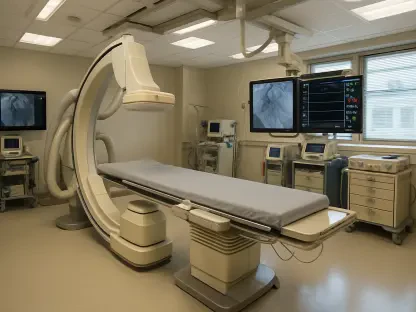In 2024, robotic surgery is rapidly transforming the healthcare landscape, bringing unprecedented advancements in precision, control, and efficiency to surgical procedures. With significant innovations and improvements in robotic surgical systems, both patients and healthcare providers stand to benefit immensely. A notable development is the collaborative effort by the University of South Florida and Tampa General Hospital, in partnership with Medical Microinstruments Inc., to incorporate the Symani Surgical System for enhancing soft-tissue open surgery. This article delves into various aspects of how robotic surgery is revolutionizing healthcare, from expanded adoption to the integration of artificial intelligence.
The Growing Adoption of Robotic Surgery
Enhanced Precision and Control for Surgeons
The Symani Surgical System, a state-of-the-art robotic platform, offers surgeons exceptional precision and control, particularly useful in delicate procedures such as microvascular and lymphatic repairs. Traditionally, these intricate surgeries posed significant challenges due to the limitations of human dexterity. With the Symani system, surgeons now have augmented capabilities to perform highly detailed operations with improved outcomes. This enhanced precision is especially beneficial for patients suffering from conditions like cancer-related lymphedema, where meticulous tissue handling is crucial for successful treatment.
Moreover, robotic surgery platforms are known for improving surgical outcomes by reducing complications, enhancing safety, and shortening recovery times. Established systems, such as Intuitive Surgical’s da Vinci robots, continue to dominate the market with their latest iteration, the da Vinci 5. These robots offer unparalleled assistance in various surgical fields, ranging from general surgery to specialized areas like gynecology and urology. As a result, patients experience less post-operative pain, minimal scarring, and quicker return to daily activities, reinforcing the growing reliance on robotic systems in modern healthcare.
Competitive Landscape and Market Dynamics
The field of robotic surgery is witnessing intense competition, with both established medical technology giants and innovative new entrants driving market dynamics. Notable companies such as Stryker, Medtronic, and Johnson & Johnson are vying for market share with their advanced robotic platforms. For instance, CMR Surgical’s Versius Surgical System has gained significant traction, recently securing FDA approvals and expanding its presence in healthcare facilities. These developments exemplify the competitive surge within the industry, showcasing the continuous evolution and refinement of surgical robots.
Furthermore, the emphasis on creating smaller, more modular devices is reshaping the robotic surgery landscape. Increased competition has led to the development of compact, versatile systems that can be easily integrated into various surgical environments. These advancements ensure that a broader range of healthcare providers can access and benefit from robotic surgery technologies. As a result, patients across diverse demographics are receiving state-of-the-art surgical care, highlighting the democratization of advanced medical treatments through robotic innovations.
Expanding Use in Ambulatory Surgery Centers
Integration of Orthopedic Robots
There’s been a significant push towards incorporating robotic systems in Ambulatory Surgery Centers (ASCs), particularly in orthopedic procedures. Orthopedic robots are increasingly being used for large-joint replacements, such as knee and hip surgeries. This trend is exemplified by architectural firm Perkins Eastman’s design of a robotic surgery-focused ambulatory center. By integrating robotic technology into ASCs, these centers can offer specialized procedures with enhanced precision and reduced recovery times, ultimately benefiting patients who prefer outpatient care.
Moreover, the potential for robotic systems to be used in spine surgeries within ASCs is gaining attention. Machines like the Mako Shoulder and Stryker’s Spine robots utilize advanced AI to assist surgeons in preoperative planning and real-time decision-making. This innovation not only enhances the accuracy of surgical interventions but also minimizes the risks associated with complex spinal operations. By leveraging AI-driven robotic systems, ASCs are poised to become pivotal players in delivering high-quality, minimally invasive surgical care to a larger patient population.
Strategic Expansions and Innovations
Healthcare organizations are strategically expanding their robotic surgery offerings to capitalize on this growing trend. Tenet Health, for example, has made significant investments in establishing robotic surgery programs within its network of ASCs. By deploying advanced robotic systems, Tenet aims to attract patients seeking high-tech, outpatient surgical solutions. These initiatives underscore the importance of embracing cutting-edge technology to meet the evolving demands of modern healthcare.
The overall effectiveness of robotic-assisted surgeries in ASCs is further bolstered by continuous innovation and research. Engineers and medical scientists are working tirelessly to refine robotic platforms, introducing new functionalities and improving existing ones. Continuous feedback from surgeons and healthcare providers drives these enhancements, ensuring that robotic systems stay at the forefront of surgical technology. This iterative process of improvement underscores the transformative potential of robotic surgery in delivering superior patient outcomes efficiently and effectively.
The Integration of Artificial Intelligence
Advancements in AI-Driven Surgical Tools
Artificial intelligence (AI) is increasingly becoming an integral component of robotic surgical systems, offering groundbreaking capabilities to enhance surgical precision and efficiency. AI-driven tools like Stryker’s Mako robots are revolutionizing preoperative planning, allowing surgeons to create highly detailed surgical plans based on sophisticated algorithms and real-time data analysis. These AI-enhanced systems enable more accurate and consistent surgical outcomes, reducing the margin for human error and optimizing patient care.
Additionally, Intuitive Surgical’s AI tool, Case Insights, exemplifies the innovative uses of AI in post-surgical analysis. Case Insights provides surgeons with detailed feedback on their performance, highlighting areas for improvement and ensuring that each procedure benefits from cumulative knowledge. In the near future, this tool aims to offer real-time feedback during surgeries, further streamlining the surgical process and enhancing decision-making capabilities. The integration of AI into robotic surgery is not just a technological advancement; it represents a paradigm shift in how surgeries are planned, executed, and analyzed, making healthcare smarter and more efficient.
Reducing Surgeon Workload and Enhancing Consistency
One of the most promising aspects of AI in robotic surgery is its potential to automate repetitive tasks, thereby reducing the workload on surgeons and increasing overall consistency in surgical procedures. Tasks such as suturing and tissue dissection, often time-consuming and requiring high levels of precision, can now be performed by AI-driven robots. This automation not only speeds up surgical procedures but also ensures that these repetitive tasks are carried out with consistent accuracy, reducing the likelihood of complications and improving patient outcomes.
Furthermore, AI’s role in surgical training is becoming increasingly significant. Advanced robotic systems with integrated AI can simulate various surgical scenarios, providing trainees with practical experience without the risks associated with real-life operations. This hands-on training, combined with real-time feedback provided by AI tools, enhances the learning curve for new surgeons, making them more adept and confident in performing complex procedures. By fostering a new generation of skilled surgeons, AI-driven robotic systems are ensuring the sustainability and advancement of surgical care in the long term.
Future Considerations
Continuous Innovation and Research
As we look ahead, continuous innovation and research will remain pivotal in the evolution of robotic surgery. Collaborative efforts between medical institutions, technology firms, and research organizations will drive further advancements in robotic systems. These partnerships will likely yield even more sophisticated technologies, pushing the boundaries of what is possible in surgical care. Researchers are already exploring areas such as haptic feedback, which could provide surgeons with a tactile sense during robotic procedures, further enhancing precision and control.
Another exciting frontier is the development of teleoperated robotic systems. These systems could enable surgeons to perform procedures from remote locations, expanding access to high-quality surgical care to underserved and rural areas. By leveraging advanced telecommunications and robotic technology, teleoperated systems have the potential to bridge geographical gaps, ensuring that patients receive the best possible care regardless of their location. This democratization of surgical expertise could significantly impact global health outcomes, making advanced medical treatments accessible to a wider population.
Addressing Challenges and Ensuring Accessibility
In 2024, robotic surgery is significantly transforming the healthcare industry, introducing remarkable advancements in precision, control, and efficiency to surgical procedures. With substantial innovations and upgrades in robotic surgical systems, the benefits for both patients and healthcare professionals are considerable. One prominent development is the collaborative initiative by the University of South Florida and Tampa General Hospital, in conjunction with Medical Microinstruments Inc., to implement the Symani Surgical System to enhance soft-tissue open surgery. This collaboration highlights the increasing integration of advanced robotic systems in healthcare settings.
The impact of robotic surgery extends beyond just technological innovation; it represents a broader shift towards the incorporation of artificial intelligence in medicine. These advancements are leading to more widespread adoption of robotic systems, thereby improving surgical outcomes and patient recovery times. This article explores how robotic surgery is revolutionizing healthcare through increased precision, reduced invasiveness, and overall improvement in surgical efficiency.









